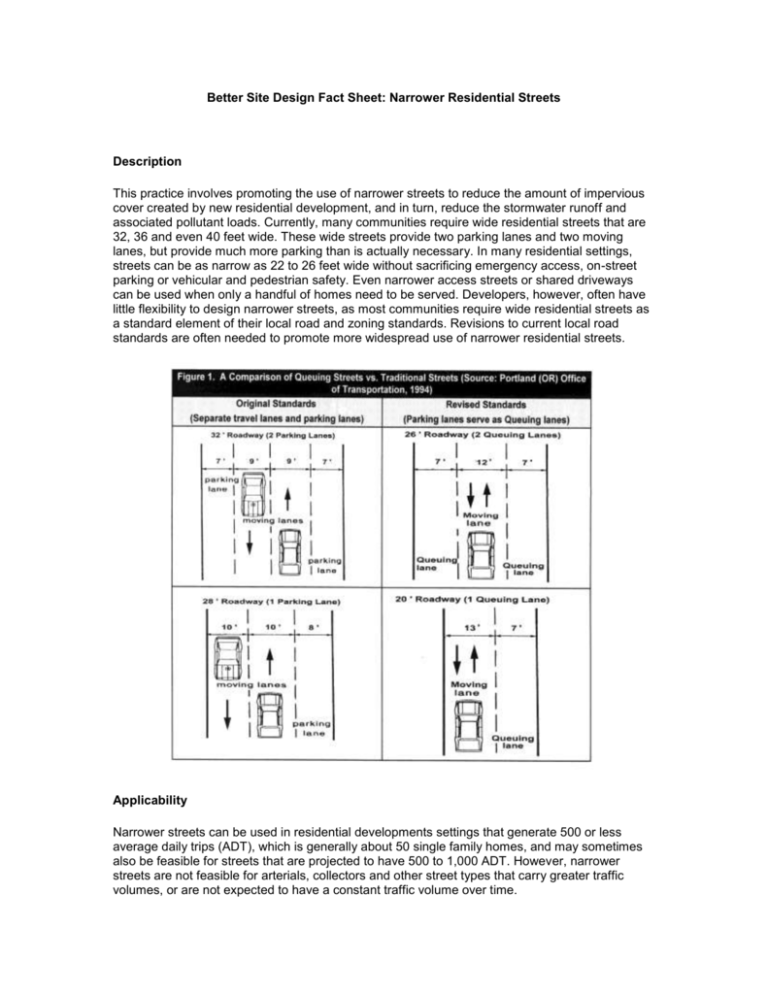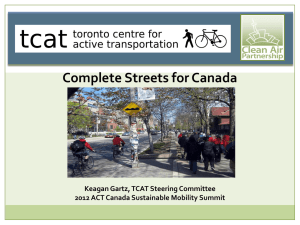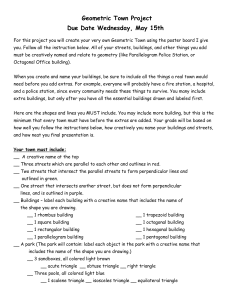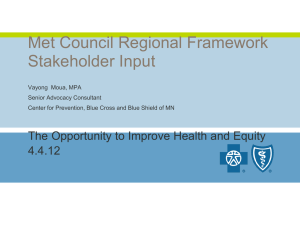Narrower Residential Streets
advertisement

Better Site Design Fact Sheet: Narrower Residential Streets Description This practice involves promoting the use of narrower streets to reduce the amount of impervious cover created by new residential development, and in turn, reduce the stormwater runoff and associated pollutant loads. Currently, many communities require wide residential streets that are 32, 36 and even 40 feet wide. These wide streets provide two parking lanes and two moving lanes, but provide much more parking than is actually necessary. In many residential settings, streets can be as narrow as 22 to 26 feet wide without sacrificing emergency access, on-street parking or vehicular and pedestrian safety. Even narrower access streets or shared driveways can be used when only a handful of homes need to be served. Developers, however, often have little flexibility to design narrower streets, as most communities require wide residential streets as a standard element of their local road and zoning standards. Revisions to current local road standards are often needed to promote more widespread use of narrower residential streets. Applicability Narrower streets can be used in residential developments settings that generate 500 or less average daily trips (ADT), which is generally about 50 single family homes, and may sometimes also be feasible for streets that are projected to have 500 to 1,000 ADT. However, narrower streets are not feasible for arterials, collectors and other street types that carry greater traffic volumes, or are not expected to have a constant traffic volume over time. In most communities, existing local road standards will need to be modified to permit the use of narrower streets. The following table includes communities that have adopted narrow street width standards. Table 1. Examples of Narrow Residential Street Widths (adapted from: Cohen, 2000 and CWP, 1998) State Jurisdiction Standard Arizona City of Phoenix 28'(parking on both sides) California City of Novato 24' (both sides, 2 to 4 du ) 28' (both sides, 5 to 15 du) Colorado City of Boulder 20' (150 ADT) 20' (no parking, 350 - 1000 ADT) 22' (one side, 350 ADT) 26' (both sides, 350 ADT) 26' (one side, 500 - 1000 ADT) Delaware Delaware DOT 21' (one side) Florida City of Orlando 28' (both sides, res. lots <55' wide) 22' (both sides, res. lots >55' wide) Maine City of Portland 24' (one side) Maryland Howard County 24' (1000 ADT) Michigan City of Birmingham 26' (both sides) 20' (one side) Montana City of Missoula 26' (both sides, 3 - 80 du) 32' (both sides, 81 - 200 du) 12' (alley) New Mexico Albuquerque 28' (one side) New Jersey 20' (no parking, 0 -3500 ADT) 28' (one side, 0 - 3500 ADT) Oregon City of Portland Pennsylvania Bucks County 26' (both sides) 20' (one side) 12' (alley) 16-18' (no parking, 200 ADT) 20-22' (no parking, 200 - 1000 ADT) 26' (one side, 200 ADT) 28' (one side, 200 - 1000 ADT) Tennessee 22' (<240 ADT) City of Johnson City 24' - 28' (240-1500 ADT) 28' (>1500 ADT) Vermont City of Burlington 30' (both sides) Washington City of Kirland 12' (alley) 20' (one side) 24' (both sides, low density only) 28' (both sides) W. Virginia Morgantown 22' (one side) Wisconsin City of Madison 27' (both sides, <3 du/ac) 28' (both sides, 3 - 10 du/ac) ADT = average daily traffic du = dwelling unit Siting and Design Conditions Residential street design requires a careful balancing of many competing objectives: design, speed, traffic volume, emergency access, parking, and safety, to name a few. Communities that want to change their road standards to permit narrower streets need to involve all the stakeholders who influence street design in the revision process. Several excellent references on narrow street design are provided at the end of this fact sheet. Limitations There are a number of real and perceived barriers to wider acceptance of narrower streets at the local level. And certainly, advocates for narrower streets will need to respond to the concerns of many local agencies and the general public. Some of the more frequent concerns about narrower streets are debunked below. Inadequate On-street Parking. Recent research and local experience have demonstrated that narrow streets can easily accommodate residential parking demand. A single family home typically requires 2 to 2.5 parking spaces. In most residential zones, this parking demand can be easily satisfied by one parking lane on the street and driveways. Car and Pedestrian Safety. Recent research indicates that narrow streets have lower accident rates than wide streets. Narrow streets tend to lower the speed of vehicles and act as traffic calming devices. Emergency Access. When designed properly, narrower streets can easily accommodate fire trucks, ambulances and other emergency vehicles. Large vehicles. Field tests have shown that school buses, garbage trucks, moving vans and other large vehicles can generally safely negotiate narrower streets, even when cars are parked on both sides of the street. In regions with high snowfall, streets may need to be slightly wider to accommodate snow plows and other equipment. Utility Corridors. It is often necessary to place utilities underneath the street rather than in the right of way. In addition, local communities may lack the authority to change road standards when the review of public roads is retained by state agencies. In these cases, street narrowing can only be accomplished if the street is private (i.e., maintained by residents rather than a local or state agency). Maintenance Considerations Narrower streets should slightly reduce road maintenance costs for local communities, since they present a smaller surface area to maintain and repair. Effectiveness Since streets constitute the largest share of impervious cover in residential developments (about 40 to 50%), a shift to narrower streets can result in a five to 20% overall reduction in impervious area for a typical residential subdivision (Schueler, 1995). As nearly all the pollutants deposited on street surfaces or trapped along curbs are delivered to the storm drain system during storm events, this reduced imperviousness translates directly into less stormwater runoff and pollutant loadings from the development. From the standpoint of stormwater quality, residential streets rank as a major source area for many stormwater pollutants, including sediment, bacteria, nutrients, hydrocarbons and metals (Steuer et al, 1997, and Bannerman, 1994). For more information see Skinny and One-sided Sidewalks: A Strategy for Not Paving Paradise, Article 50 in the Practice of Watershed Protection. Cost Considerations It makes sense that narrower streets cost less to build than wider streets. Considering that the cost of paving a road averages $15 per square yard, shaving even a mere four feet from existing street widths can yield cost savings of more than $35,000 per mile of residential street. In addition, since narrower streets produce less impervious cover and runoff, additional savings can be realized in the reduced size and cost of downstream stormwater management facilities. References American Association of State Highway and Transportation Officials (AASHTO). 1994. A Policy on Geometric Design of Highways and Streets. AASHTO Publications, Washington D.C. Bannerman, R. 1994. Sources of Pollutants in Wisconsin Stormwater. Wisconsin Dept. of Natural Resources. Milwaukee, WI. Bucks County Planning Commission. 1980. Performance Streets: A Concept and Model Standards for Residential Streets. Doylestown, PA. Center for Watershed Protection (CWP). 1998. Better Site Design: A Handbook for Changing Development Rules in Your Community. Ellicott City, MD. Cohen, A. Narrow Streets Database. Congress for the New Urbanism. Available online at: www.sonic.net/abcaia/narrow.htm Ewing, Reid. 1996. Best Development Practices: Doing the Right Thing and Making Money at the Same Time. American Planning Association, Planners Book Service. Chicago, Il. Institute of Traffic Engineers. 1997. Traditional Neighborhood Development Street Design Guidelines. Washington, D.C. Portland Office of Transportation. 1994. Report on New Standards for Residential Streets in Portland, Oregon. City of Portland. Portland, OR. Schueler, Thomas R. Site Planning for Urban Stream Protection. Center for Watershed Protection, Ellicott City, MD. Urban Land Institute. Residential Streets (Second Edition). Washington, D.C.





